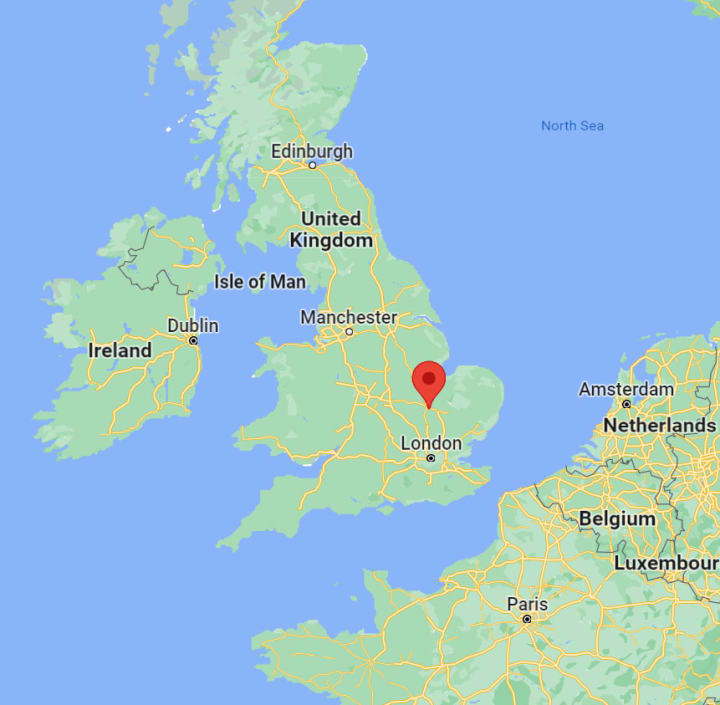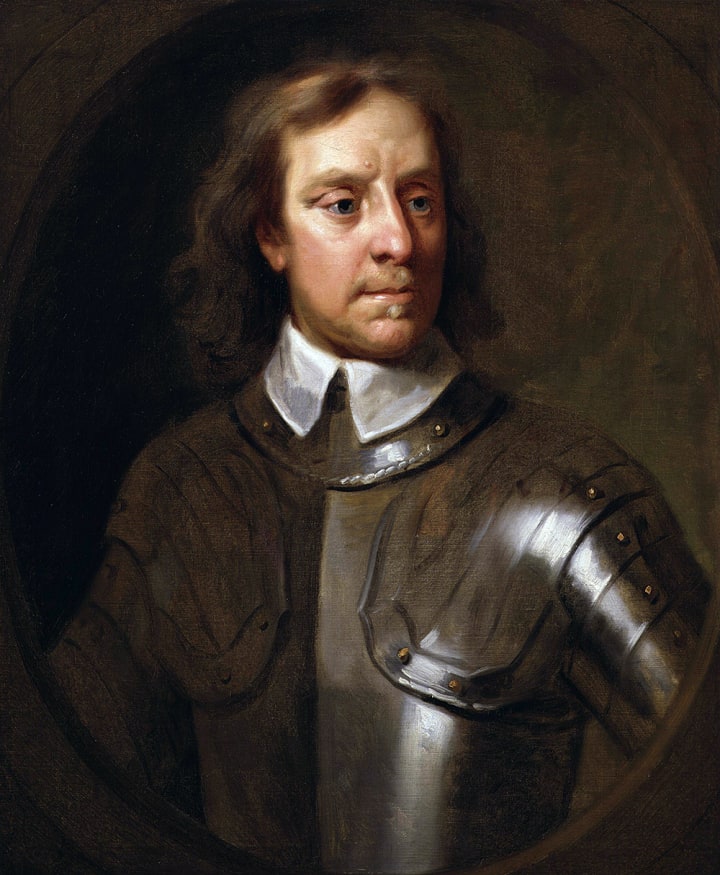The Posthumous Execution of Oliver Cromwell
A man so hated that his corpse was executed.

Some events from history are so strange that we should all take a moment, look back, and collectively say WTF. This is one of those. It's about a man so hated that his corpse was dug up for the sole purpose of mutilating it because being dead wasn't good enough (bad enough?) for those who hated him. Can you think of anything more hate-fueled that could happen to a dead body?
The Humble Beginnings of Oliver Cromwell
Oliver Cromwell was born in 1599 in a small town called Huntingdon, about an hour and a half drive north of London.

Cromwell briefly attended Cambridge University and dropped out after only about a year. Some historians say that Cromwell lived a typical country life—spending his days complaining about the weather and sometimes attending local fairs. He even joined the Parliament for Huntingdon, probably looking for some good old-fashioned political debates to pass the time.
(This section is relatively short because the "becoming a tyrant" part is more interesting.)
Civil Unrest and the Rise of England's "Not-King"
Around the same time that Oliver Cromwell was poking around Huntingdon, looking for something to do, the country around him began exploding in turmoil. In a typical English fashion, the citizens held a friendly discourse over the best way to make tea, the minutiae of Christian theology as it related to which denominations were damned and going to Hell, and the limits of the divine right of kings.
King Charles I thought he had the divine right to rule, which basically meant, "God said I can do whatever I want." Meanwhile, Parliament believed in this weird concept called "democracy." Tensions simmered, name-calling and rude gestures were exchanged, and soon enough, the power struggle pot began to boil over. Throw in a dash of religious disagreements, a sprinkle of economic challenges, and voilà: The English Civil War.
Back in Huntingdon, Oliver Cromwell had been spending his time learning more about turnips than tactics. However, when the war kicked off, sly-eyed Cromwell saw an opportunity. What opportunity?
Well, to become a tyrant, of course.
Swapping his country life complaints for a shiny new suit of armor, he raised a small band of troops, then an army, and in a twist no one saw coming, Oliver demonstrated actual talent as a military commander. Cromwell's forces were part of the New Model Army (yes, that was the actual name), a military force of Parliamentarians (founded by Puritans) who thought King Charles I needed to respect their not-divine-right authority to do whatever they wanted.

The Parliament sought to reign in King Charles I from his divine right to financial corruption, forcing his views of religion down people's throats and imprisoning anyone who disagreed with him. Oh, and worst of all, not seeking Parliamentary approval.
Cromwell's forces captured King Charles I in 1646, briefly lost him, and recaptured him in 1648. Suddenly, Cromwell's penchant for religious zealotry and his talent for military strategy made him the darling of the Puritan cause.
Off with His Head: Charles I Meets the World's Sharpest Unsubscribe Button
In 1649, the Rump House of Commons indicted King Charles I for treason. The House of Lords rejected the charge of treason, and the Chief Justices of the three common law courts of England declared the indictment unlawful. The Rump House of Commons indictment of King Charles I for treason was dead.
Totally unrelated, the Rump House of Commons passed a bill creating a separate court and declared the bill an act (without the need for royal assent). The new court's first order of business: indict King Charles I for treason. The details of the charges against Charles I were vast, including using his divine-right powers for personal interest, making war against Parliament, and being responsible for an estimated 300,000 people (about 6% of the entire population) who died during the English Civil War.
When the court asked Charles I how he pleaded to the charges, he replied with a metaphorical middle-finger salute and insisted that he could do whatever he wanted because it was his divine right. Charles I was convicted and sentenced to death. Fifty-nine commissioners (judges) signed his death warrant, including Oliver Cromwell.

Charles I kept on it was his god-given right to do whatever he wanted right up until January 30, 1649, when his tenure was cut short, and he was severed from his position as king by a single clean slice of an executioner's ax. The gathered crowd collectively decided that this momentous event should not pass without some kind of souvenir, so they dipped their handkerchiefs in the fresh blood dripping from his corpse.
After the execution, Cromwell's ambition didn't stop at simply leading an army responsible for killing a king, and soon, the once-unremarkable university dropout became the Lord Protector of England, Scotland, and Ireland.
Lord Protector—not a king—because the title of king was so passé, and Oliver Cromwell would rather have a title that sounded like a brand of sunblock than ever to be called king.

As the very first Lord Protector ever, he became the first person not of royal blood to be head of state. So…like a king, except no one was allowed to call him king.
In 1657, the Parliament offered the crown to Cromwell because they evidently hadn't heard Cromwell's opinion about kings. Cromwell—obviously—told them no. About a year later, in 1658, Cromwell died from malarial fever and complications of kidney stone disease. There was a treatment available at the time (quinine), but due to that religious zealotry of his I mentioned earlier, he refused treatment because quinine had been discovered by Catholic Jesuit missionaries. And so, the story of Oliver Cromwell came to a close, and his body was laid to rest in Westminster Abbey.

Post-Mortem Politics: Oliver Cromwell's "Un-live" Trial and Ultimate Undead Undoing
Immediately after Cromwell's death in 1658, things in England began shifting back to the monarchy's way of life. Oliver Cromwell's son, Richard, was supposed to pick up the duty of Lord Protector when Oliver died, but no one wanted him, and he was quickly forced to resign. With no clear leadership, a few constitutional adjustments were made, and Charles II, the eldest surviving son of Charles I, returned from exile and became king.
One of Charles II's first orders of business: revenge.
In January of 1661, on the 12th anniversary of the execution of King Charles I, Oliver Cromwell's body was exhumed so his corpse could be put on trial for treason and regicide.
The trial took place in a typical courtroom with a judge, jury, and the accused. Only in this case, the accused was a three-year-old rotten, probably stinking corpse. As you might expect, the defense strategy of a thousand-mile-stare with dead eyes didn't go over so well, and Oliver Cromwell's corpse was found guilty.
So, Oliver Cromwell's corpse was hanged at Tyburn, London, and then thrown into a pit. His head was then chopped off and stuck on a pole outside Westminster Hall, where it sat until 1685.
Yeah…like twenty-four years.
It was then sold off to the highest bidder and changed owners several times for years after, occasionally getting put on public display. A few centuries later, in 1960, Oliver Cromwell's head was again laid to rest in a somewhat secretive location.
If you're wondering what happened to his body, no one really knows. The leading theory is that his body was reburied but had to be frequently moved because vengeful royalists were constantly chasing it down to further mutilate it.
Totally normal.
Isn't history fun?
Relevant & Related
- Interested in more history of the time? Check out The Life & Times of Oliver Cromwell... Without Cromwell
- There are some great documentaries available for free on The English Civil War, Oliver Cromwell, and his corpse desecration—ahem, I mean "posthumous execution": Oliver Cromwell - The King Killer Documentary || The English Civil War - Oliver Cromwell & King Charles I Documentary || Oliver Cromwell vs Ireland: An Endless Cycle Of Violence
- A lot has been written about this period of English history. Here are five books specific to Oliver Cromwell that you might enjoy.
- Prefer fictionalized accounts of history? Try the 1970 film Cromwell or the 2003 film To Kill a King.
- Other articles you might enjoy: Morgawr of Cornwall, England | Brown Lady of Raynham Hall in Norfolk, England | Gilles de Rais | Owlman of Mawnan, Cornwall | Benjamin Franklin's Basement
~
Originally published in my weekly newsletter Into Horror History - every week, I explore the history and lore of horror, from influential creators to obscure events. Cryptids, ghosts, folklore, books, music, movies, strange phenomena, urban legends, psychology, and creepy mysteries.
About the Creator
J.A. Hernandez
J.A. Hernandez enjoys horror, playing with cats, and hiding indoors away from the sun. Also, books. So many books—you wouldn't believe.
He runs a weekly newsletter called Into Horror History and writes fiction.
https://www.jahernandez.com







Comments (9)
Congratulations on your top story.
I thought Mussolini got it worse... A very revealing story...
To say this is an interesting story would be an understatement. Thanks for sharing this weird bit of history! Congratulations on Top Story!
Great summary of Cromwell's life and career. You can still stand on the spot where his remains were posthumously hanged. There is a plaque in the roadway at Marble Arch, marking the place where the infamous Tyburn Tree gallows stood. You can also see Cromwell's statue outside the House of Commons, not far from a statue of King Richard I, known as "Coeur de Lion" and just around the corner from Abraham Lincoln, among other historical figures. The Civil War instigated by Cromwell also saw the City of London Corporation raise arms against the King. The Corporation, to this day, jealously guards its ancient privileges. King Charles I was not the only King to be deposed by Parliament. In 1688 James II (King James VII of Scotland) was chased out of England and Scotland, to be replaced by William of Orange (William III) and Mary (II) in the 'Glorious Revolution' - no beheadings this time around! As recently as 1936, King Edward was replaced by George VI and only a few years ago, the royal lineage was again altered by the Succession to the Crown Act 2013, which bumped up Princess Charlotte's position above that of her brother, Prince Louis. If second in line to the throne, Prince George, were to die without issue, Charlotte would become Queen upon William's death. Great historical piece and will look forward to reading more.
outstanding
Amazing job! Keep up the outstanding work—congrats!
"As you might expect, the defense strategy of a thousand-mile-stare with dead eyes didn't go over so well, and Oliver Cromwell's corpse was found guilty." As the kids say nowadays: "I'm dead."
There is a programme in the UK called Horrible Histories which does a rap about King Charles II called "The King who brought back partying". Cromwell's years of puritan living tired us Brits out by boring us into inaction and so, divine right or not, the King was the man for us. He was one of the most popular monarchs although I am sure he was a guilty of largesse as many others. I did not know about Cromwell's corpse trial. My God, how macabre. Good job he was dead already as vengeance would have been pretty cruel for him.
I love this story (despite all the horrible things around it). As someone living in a time of computers, the thought of putting a corpse on trial and then executing it is mindblowing.